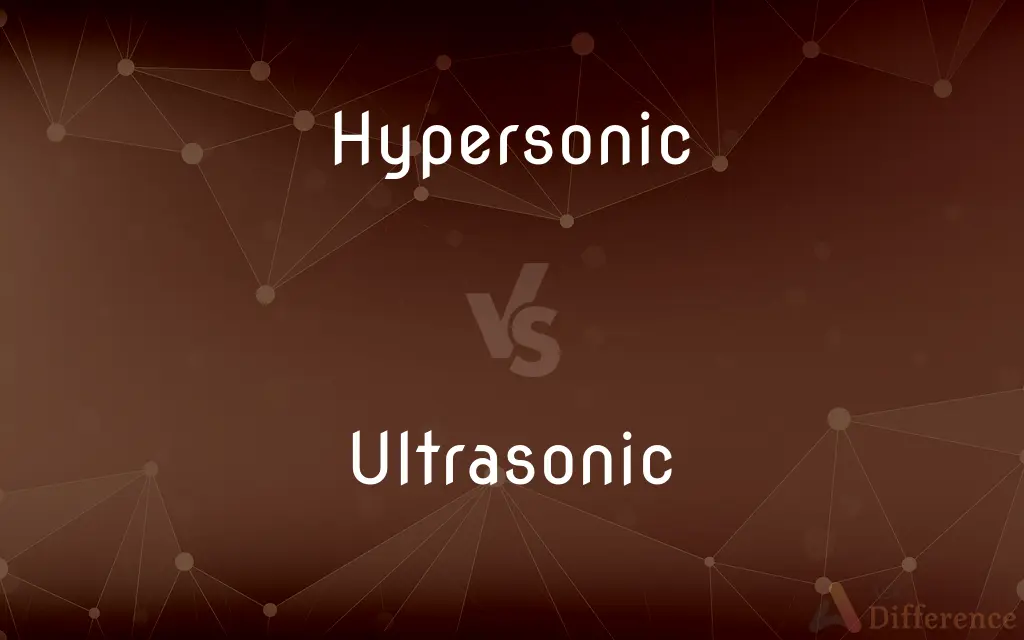Hypersonic vs. Ultrasonic — What's the Difference?
By Tayyaba Rehman & Maham Liaqat — Updated on March 8, 2024
Hypersonic refers to speeds above Mach 5, while ultrasonic pertains to sound frequencies above 20 kHz.

Difference Between Hypersonic and Ultrasonic
Table of Contents
ADVERTISEMENT
Key Differences
Hypersonic relates to speeds that exceed five times the speed of sound (Mach 5), often discussed in the context of aerospace engineering and military applications. Ultrasonic, on the other hand, describes sound waves with frequencies higher than the upper audible limit of human hearing, typically above 20,000 hertz (20 kHz), and is widely used in medical imaging and industrial applications.
The term hypersonic is primarily associated with aircraft, missiles, and spacecraft that travel at exceptionally high speeds, crucial for advanced aerospace technology and defense systems. Ultrasonic frequencies, while inaudible to humans, play a significant role in applications like sonography or ultrasound imaging, non-destructive testing, and cleaning processes.
Hypersonic travel involves complex aerodynamics, as objects moving at such speeds must withstand extreme temperatures and pressures, requiring advanced materials and engineering. Ultrasonic technology, in contrast, focuses on the propagation of high-frequency sound waves through various media to visualize, measure, or clean objects.
The study of hypersonic speeds includes understanding shock waves, boundary layers, and heat transfer at velocities exceeding 3,836 mph (6,174 km/h) at sea level. Ultrasonic applications, however, utilize the reflection, refraction, and attenuation of sound waves in different materials to achieve desired outcomes like imaging internal body structures or detecting flaws in materials.
While hypersonic technology is key to future transportation and defense capabilities, potentially reducing global travel times significantly, ultrasonic technology has become indispensable in healthcare for diagnostics, treatment, and also in various industrial processes.
ADVERTISEMENT
Comparison Chart
Definition
Pertaining to speeds greater than five times the speed of sound (Mach 5).
Relating to sound frequencies above the upper audible limit of human hearing (>20 kHz).
Primary Application
Aerospace engineering, military technology.
Medical imaging, industrial cleaning, non-destructive testing.
Key Challenges
Extreme temperatures, pressure, material engineering.
Wave propagation through different media, resolution of imaging.
Usage Examples
Hypersonic missiles, aircraft, spacecraft.
Ultrasound imaging, sonar systems, industrial cleaning.
Importance
Critical for advancing high-speed travel and defense capabilities.
Essential in healthcare diagnostics, industrial processes, and environmental studies.
Compare with Definitions
Hypersonic
Traveling at velocities exceeding Mach 5.
Hypersonic missiles are designed to travel at speeds unreachable by traditional defense systems.
Ultrasonic
Sound frequencies above 20 kHz, inaudible to humans.
Ultrasonic waves are used in medical sonography to create images of internal body structures.
Hypersonic
Primarily used in advanced aerospace technologies and military applications.
Hypersonic research aims to revolutionize space travel and global defense strategies.
Ultrasonic
Non-destructive testing to detect flaws or characterize materials.
Ultrasonic testing can identify cracks or imperfections within metals without damaging them.
Hypersonic
Overcoming issues related to heat and pressure at high velocities.
Developing materials that can withstand the extreme conditions faced by hypersonic vehicles is a key research area.
Ultrasonic
A cornerstone in diagnostic techniques like ultrasound.
Ultrasonography is a non-invasive method used to examine organs, vessels, and tissues.
Hypersonic
Potential to drastically reduce global travel times.
Hypersonic aircraft could make intercontinental travel possible in just a few hours.
Ultrasonic
Used in cleaning, testing, and processing in various industries.
Ultrasonic cleaners use high-frequency sound waves to remove contaminants from delicate items.
Hypersonic
Studying complex aerodynamic phenomena unique to hypersonic speeds.
Understanding shock wave behavior is crucial for designing efficient hypersonic vehicles.
Ultrasonic
Utilized in studying ecosystems and animal behavior.
Ultrasonic tracking devices are used to monitor the movements and behaviors of certain wildlife species.
Hypersonic
Of, relating to, or capable of speed equal to or exceeding five times the speed of sound.
Ultrasonic
Of or involving sound waves with a frequency above the upper limit of human hearing.
Hypersonic
Equal to, or greater than, or capable of achieving, five times the speed of sound.
Ultrasonic
Of or relating to acoustic frequencies above the range audible to the human ear, or above approximately 20,000 hertz.
Hypersonic
Far enough above the speed of sound as to cause significant differences in behaviour due to chemical reactions or dissociation of the air.
Ultrasonic
Of, relating to, or involving ultrasound.
Hypersonic
Pertaining to or moving at a speed greatly in excess of the speed of sound, usually meaning greater than mach 5. All speeds in excess of the speed of sound are supersonic, but to be hypersonic requires even higher speed.
Ultrasonic
(acoustics) Beyond (higher in frequency than) the range of sound perceptible to the human ear; with a frequency of 20 kilohertz or higher.
Ultrasonic
Having frequencies above those of audible sound
Common Curiosities
What are the challenges in hypersonic flight?
Hypersonic flight faces challenges such as extreme temperatures, pressures, and the need for advanced materials and aerodynamic designs.
What defines hypersonic speed?
Hypersonic speed is defined as travel at velocities greater than five times the speed of sound, or Mach 5.
Is hypersonic travel feasible for commercial use?
While hypersonic travel holds promise for reducing global travel times, significant technical and economic challenges remain before it becomes commercially viable.
What advancements are being made in hypersonic technology?
Advancements include the development of new materials, propulsion systems, and aerodynamic designs to enable sustained hypersonic flight.
How are ultrasonic waves used in medicine?
Ultrasonic waves are used in medical imaging, notably in ultrasound, to visualize internal body structures without invasive procedures.
Can humans hear ultrasonic sounds?
No, ultrasonic sounds have frequencies above 20 kHz, which is beyond the upper limit of human hearing.
Can ultrasonic frequencies be used for communication?
Ultrasonic frequencies are used in some specialized communication systems, including those for underwater and short-range applications.
How do ultrasonic waves interact with materials?
Ultrasonic waves can reflect, refract, and attenuate when interacting with different materials, making them useful for imaging and testing.
Are there environmental concerns with ultrasonic technology?
While generally considered safe, ultrasonic technology can impact certain wildlife and must be used responsibly, especially in sensitive environments.
What makes ultrasonic technology useful in industry?
Ultrasonic technology is valuable for its precision in cleaning, non-destructive testing, and processing materials, offering efficiency and safety.
Can ultrasonic technology be used for navigation?
Yes, ultrasonic technology is used in certain navigation systems, including those for autonomous vehicles and robotics.
How does ultrasonic imaging compare to other imaging methods?
Ultrasonic imaging is non-invasive and safe, providing real-time images without the use of ionizing radiation, making it preferred for certain medical applications.
What are the implications of hypersonic technology for global security?
Hypersonic technology could alter global security dynamics by enabling weapons and vehicles that are difficult to detect and intercept, prompting new defense strategies.
How does hypersonic speed affect aerospace engineering?
Hypersonic speeds introduce unique aerodynamic and thermal challenges, requiring innovations in aerospace engineering and materials science.
What potential does hypersonic travel have for military applications?
Hypersonic technology offers strategic advantages in military applications, including rapid response capabilities and the ability to penetrate advanced defense systems.
Share Your Discovery

Previous Comparison
Province vs. Prefecture
Next Comparison
Pharmacy vs. ApothecaryAuthor Spotlight
Written by
Tayyaba RehmanTayyaba Rehman is a distinguished writer, currently serving as a primary contributor to askdifference.com. As a researcher in semantics and etymology, Tayyaba's passion for the complexity of languages and their distinctions has found a perfect home on the platform. Tayyaba delves into the intricacies of language, distinguishing between commonly confused words and phrases, thereby providing clarity for readers worldwide.
Co-written by
Maham Liaqat












































